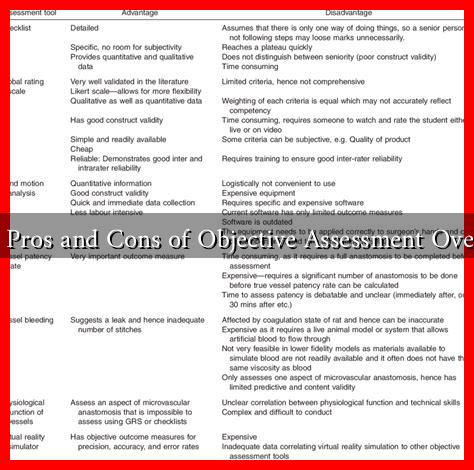-
Table of Contents
What Are the Pros and Cons of Objective Assessment Over Attendance?
In the realm of education, the debate between objective assessment and attendance as measures of student performance has gained significant traction. While attendance has traditionally been viewed as a key indicator of student engagement and success, objective assessments—such as exams, quizzes, and standardized tests—offer a different perspective. This article explores the pros and cons of using objective assessments over attendance, providing insights into their implications for students, educators, and educational institutions.
The Case for Objective Assessment
Objective assessments are designed to evaluate a student’s knowledge and skills in a standardized manner. They often include multiple-choice questions, true/false questions, and short answer formats. Here are some of the advantages of using objective assessments:
- Measurable Outcomes: Objective assessments provide quantifiable data that can be easily analyzed. This allows educators to gauge student understanding and performance accurately.
- Reduced Subjectivity: Unlike subjective assessments, which can be influenced by personal biases, objective assessments offer a level playing field for all students.
- Standardization: Objective assessments can be standardized across different classes and schools, making it easier to compare student performance on a larger scale.
- Immediate Feedback: Many objective assessments can be graded quickly, providing students with immediate feedback on their performance, which can enhance learning.
Challenges of Objective Assessment
Despite their advantages, objective assessments also come with certain drawbacks that educators must consider:
- Limited Scope: Objective assessments often focus on rote memorization rather than critical thinking or problem-solving skills. This can lead to a narrow understanding of the subject matter.
- Test Anxiety: Many students experience anxiety during exams, which can negatively impact their performance and does not accurately reflect their knowledge or abilities.
- Cheating Risks: The standardized nature of objective assessments can make them susceptible to cheating, undermining the integrity of the evaluation process.
- Neglect of Non-Academic Skills: Objective assessments typically do not account for important non-academic skills such as teamwork, communication, and creativity.
The Role of Attendance in Education
Attendance has long been considered a vital component of student success. Regular attendance is often linked to better academic performance and higher graduation rates. Here are some reasons why attendance is still valued:
- Engagement Indicator: Regular attendance often indicates a student’s engagement and commitment to their education, which can correlate with better learning outcomes.
- Social Interaction: Attending classes allows students to interact with peers and instructors, fostering a collaborative learning environment.
- Accountability: Attendance policies can instill a sense of responsibility in students, preparing them for future professional environments where attendance is crucial.
Drawbacks of Relying Solely on Attendance
While attendance has its merits, relying solely on it as a measure of student success can be problematic:
- External Factors: Students may face various challenges that affect their ability to attend classes, such as health issues or family responsibilities, which do not reflect their academic capabilities.
- Quality Over Quantity: Simply being present in class does not guarantee that a student is engaged or learning effectively.
- Potential for Misuse: Attendance policies can sometimes lead to punitive measures that may discourage students rather than motivate them.
Conclusion: Finding a Balance
In conclusion, both objective assessments and attendance have their pros and cons in evaluating student performance. Objective assessments provide measurable outcomes and reduce subjectivity, but they may not capture the full spectrum of a student’s abilities. On the other hand, while attendance can indicate engagement and accountability, it does not always reflect a student’s understanding or skills.
To create a more holistic approach to student evaluation, educators should consider integrating both methods. By combining objective assessments with attendance data, educators can gain a more comprehensive understanding of student performance and engagement. This balanced approach can lead to improved educational outcomes and better prepare students for future challenges.
For further reading on effective assessment strategies in education, you can explore resources from the Edutopia.

